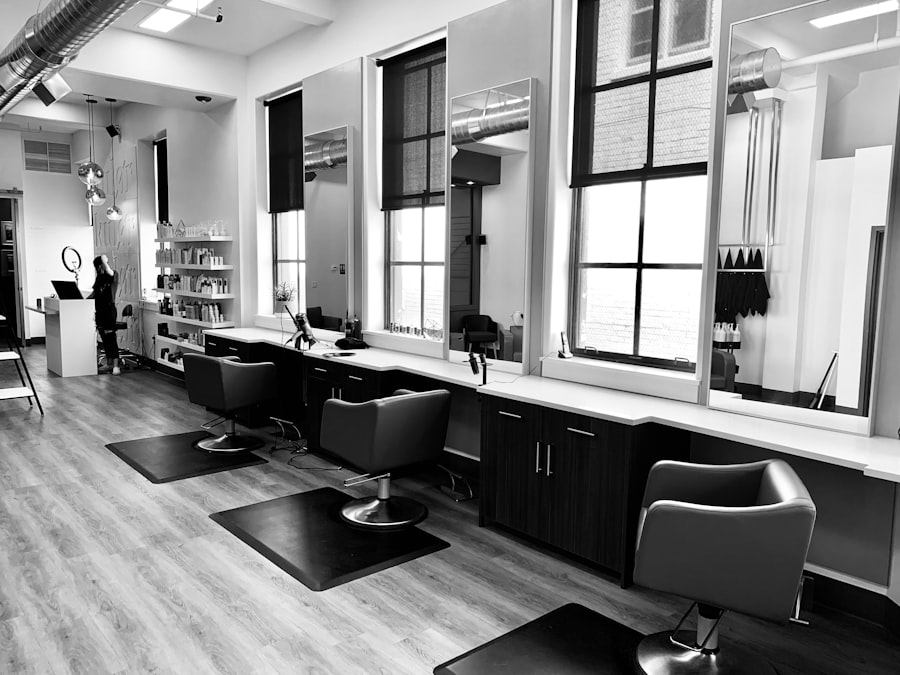
The beauty industry in the United States has witnessed a remarkable surge in demand for hairdressers, hairstylists, and cosmetologists over the past decade. This growth can be attributed to several factors, including an increasing emphasis on personal grooming and self-care, the rise of social media influencers showcasing diverse hairstyles, and a broader acceptance of various beauty standards. As individuals become more conscious of their appearance and seek to express their identities through their hairstyles, the need for skilled professionals in this field has never been greater.
According to the U.S. Bureau of Labor Statistics (BLS), employment for hairdressers, hairstylists, and cosmetologists is projected to grow by 19% from 2020 to 2030, which is significantly faster than the average for all occupations. Moreover, the COVID-19 pandemic has further highlighted the importance of personal grooming and self-care as people sought to maintain their appearance during lockdowns.
As salons and barbershops reopened, there was a rush of clients eager to return to their stylists, leading to a backlog of appointments and an increased demand for services. This trend has not only created job opportunities but has also encouraged many individuals to consider a career in this vibrant industry. The growing acceptance of diverse hairstyles and beauty practices has also opened doors for professionals who specialize in various techniques, such as braiding, coloring, and cutting, catering to a wider range of clientele.
Key Takeaways
- The demand for hairdressers, hairstylists, and cosmetologists in the USA is growing due to an increasing focus on personal grooming and appearance.
- Education and training requirements for hairdressers, hairstylists, and cosmetologists in the USA include completing a state-approved program and obtaining a license.
- There are opportunities for advancement and specialization in the hair and beauty industry, such as becoming a salon manager or a makeup artist.
- Licensing and certification are essential for hairdressers, hairstylists, and cosmetologists in the USA to ensure they meet industry standards and regulations.
- Job prospects and salary expectations for hairdressers, hairstylists, and cosmetologists in the USA are favorable, with potential for growth and higher earnings with experience and expertise.
Education and Training Requirements for Hairdressers, Hairstylists, and Cosmetologists in the USA
To embark on a career as a hairdresser, hairstylist, or cosmetologist in the United States, individuals must complete specific educational and training requirements. Most states require aspiring professionals to graduate from a state-approved cosmetology program, which typically includes both theoretical coursework and practical hands-on training. These programs can vary in length but generally last between nine months to two years, depending on whether the student attends full-time or part-time.
The curriculum often covers essential topics such as hair cutting techniques, coloring methods, chemical treatments, skin care, and makeup application. In addition to formal education, aspiring hairdressers and cosmetologists are encouraged to gain experience through internships or apprenticeships. These opportunities allow students to work alongside experienced professionals in real salon environments, honing their skills and building confidence.
Many cosmetology schools also offer job placement assistance upon graduation, helping students transition into the workforce more smoothly. Furthermore, continuing education is vital in this ever-evolving industry; professionals must stay updated on the latest trends, techniques, and products to remain competitive.
Opportunities for Advancement and Specialization in the Hair and Beauty Industry

The hair and beauty industry offers numerous opportunities for advancement and specialization for those willing to invest time and effort into their careers. After gaining experience as a stylist or cosmetologist, many professionals choose to specialize in specific areas such as hair coloring, extensions, or texture services. Specialization not only enhances a stylist’s skill set but also allows them to command higher prices for their services due to their expertise.
For instance, a stylist who becomes certified in balayage techniques can attract clients specifically seeking that service. In addition to specialization, there are various paths for career advancement within the industry. Many hairdressers and stylists aspire to become salon managers or owners, which involves taking on additional responsibilities such as staff management, marketing, and financial oversight. Others may choose to transition into education by becoming instructors at cosmetology schools or offering workshops and training sessions for fellow professionals.
The rise of social media has also created opportunities for stylists to build personal brands and become influencers themselves, showcasing their work online and attracting a larger clientele.
Licensing and Certification for Hairdressers, Hairstylists, and Cosmetologists in the USA
| State | License Required | Minimum Age | Education Required |
|---|---|---|---|
| California | Yes | 17 | 1600 hours |
| Texas | Yes | 17 | 1500 hours |
| Florida | Yes | 16 | 1200 hours |
| New York | Yes | 17 | 1000 hours |
Licensing is a crucial aspect of becoming a hairdresser, hairstylist, or cosmetologist in the United States. Each state has its own licensing requirements governed by its cosmetology board. Generally, candidates must complete an accredited cosmetology program and pass both written and practical examinations to obtain their licenses.
The written exam typically tests knowledge of safety practices, sanitation standards, and various techniques related to hair care and styling. The practical exam assesses candidates’ abilities to perform specific tasks such as cutting hair or applying color. In addition to state licensure, many professionals choose to pursue additional certifications in specialized areas of cosmetology.
For example, certification programs are available for advanced techniques like microblading or keratin treatments. These certifications can enhance a stylist’s credibility and marketability while demonstrating their commitment to ongoing education.
Job Prospects and Salary Expectations for Hairdressers, Hairstylists, and Cosmetologists in the USA
The job prospects for hairdressers, hairstylists, and cosmetologists remain robust due to the industry’s consistent growth trajectory. According to the BLS, as of May 2020, the median annual wage for hairdressers and cosmetologists was approximately $27,000; however, earnings can vary significantly based on factors such as location, experience level, and clientele. In metropolitan areas with higher living costs or larger populations, stylists often have the potential to earn substantially more through tips and commissions on product sales.
Moreover, many professionals supplement their income by offering additional services such as makeup application or skincare treatments. The ability to diversify one’s skill set can lead to increased earnings potential. Additionally, those who establish a loyal client base often find that their income grows over time as they build relationships with clients who return regularly for services.
The flexibility of working hours also allows many stylists to take on additional clients or work at multiple locations to maximize their earnings.
The Role of Creativity and Innovation in the Hair and Beauty Industry

Creativity is at the heart of the hair and beauty industry; it is what sets successful stylists apart from their peers. Hairdressers and cosmetologists are not merely technicians; they are artists who use hair as their canvas. The ability to envision unique styles that complement an individual’s features or personality is essential for creating standout looks that clients will love.
This creative aspect extends beyond just cutting or coloring hair; it encompasses understanding trends, experimenting with new techniques, and even collaborating with other beauty professionals. Innovation plays a significant role in shaping the industry as well. With advancements in technology and product development, new tools and techniques are constantly emerging.
For instance, the introduction of digital tools that allow clients to visualize different hairstyles before committing to a cut has revolutionized how stylists approach consultations. Additionally, social media platforms serve as a source of inspiration where stylists can showcase their work while also keeping abreast of current trends. This dynamic environment encourages professionals to think outside the box and continuously evolve their craft.
The Importance of Customer Service and Communication Skills in the Hair and Beauty Industry
In an industry where personal relationships are paramount, customer service skills are essential for success as a hairdresser or stylist. Building rapport with clients fosters trust and loyalty; clients are more likely to return if they feel valued and understood during their appointments. Effective communication is key in this regard; stylists must be able to listen actively to clients’ needs while also providing expert advice on styles that would suit them best.
This two-way communication ensures that clients leave satisfied with their experience. Moreover, exceptional customer service extends beyond just technical skills; it encompasses creating a welcoming atmosphere within the salon or spa environment. Simple gestures such as offering refreshments or engaging in friendly conversation can significantly enhance a client’s experience.
Stylists who prioritize customer service often find that they receive more referrals from satisfied clients looking to share their positive experiences with friends and family.
Tips for Success and Growth in a Career as a Hairdresser, Hairstylist, or Cosmetologist in the USA
For those aspiring to thrive in the competitive world of hairdressing or cosmetology, several strategies can facilitate success and growth within this dynamic field. First and foremost is the importance of networking; building relationships with other professionals can lead to valuable mentorship opportunities or collaborations that enhance one’s skill set. Attending industry events such as trade shows or workshops can also provide exposure to new techniques while allowing stylists to connect with potential clients.
Additionally, embracing continuous learning is vital in an industry that evolves rapidly.
Finally, leveraging social media platforms effectively can help stylists showcase their work while attracting new clientele; sharing before-and-after photos or tutorials can engage followers while establishing a stylist’s brand identity within the beauty community.
By focusing on these aspects—networking, continuous learning, and effective marketing—hairdressers, hairstylists, and cosmetologists can carve out successful careers while contributing positively to the ever-evolving landscape of the beauty industry in the United States.
If you are interested in learning more about the world of Hairdressers, Hairstylists, and Cosmetologists in the USA, you may want to check out this article on careersintheusa.com. This article provides valuable insights into the industry and offers tips on how to succeed in this competitive field. Additionally, you can explore more career options and resources on their sample page or browse through their website for more information on various professions in the USA.
FAQs
What is the job outlook for hairdressers, hairstylists, and cosmetologists in the USA?
The job outlook for hairdressers, hairstylists, and cosmetologists in the USA is projected to grow 19 percent from 2020 to 2030, which is much faster than the average for all occupations.
What are the typical job duties of hairdressers, hairstylists, and cosmetologists?
Hairdressers, hairstylists, and cosmetologists typically provide hair care services such as cutting, coloring, and styling hair. They may also provide scalp treatments, facial treatments, and makeup application.
What are the educational requirements for becoming a hairdresser, hairstylist, or cosmetologist in the USA?
In the USA, hairdressers, hairstylists, and cosmetologists are required to complete a state-approved cosmetology or hairstyling program, which typically takes about 9 months to 2 years to complete. They must also obtain a state-issued license to practice.
What are the potential career advancement opportunities for hairdressers, hairstylists, and cosmetologists?
Hairdressers, hairstylists, and cosmetologists may advance to become salon or spa managers, or they may choose to open their own salon or spa. Some may also become educators in cosmetology schools or work as platform artists for product manufacturers.
What is the median pay for hairdressers, hairstylists, and cosmetologists in the USA?
The median pay for hairdressers, hairstylists, and cosmetologists in the USA was $26,270 per year in 2020, according to the U.S. Bureau of Labor Statistics.






